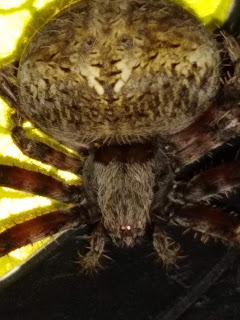The seasons change, and there is a definite change to yellows and oranges after the first frost yesterday. The leaves have begun to fall and most animals have changed from hunting for insects and berries to eating seeds and roots.
The gorgeous sunsets and sunrises are courtesy of winds in front of a cold fronts, as well as the smoke from California fires, which have returned this week.
I found this patch of fascinating fungi at the Heidi's raspberry patch. "Birds nest fungi" reverse the usual mushroom umbrella shape and the "egg" is a device to use raindrop energy to splatter spores out into the nearby vegetation.
Most insects are starting to die as the cold signals the end of their life cycles. For some reason, the moths continue to be present. They may just be migrating through the area. The Datura moths are likely gone, as their delicate flowers has vanished. The purple asgters continue to attract insects during the hottest part of the day. This raptor remains as an enigma to me. I do not yet have a definitive ID, but that is not too unusual, I do not know that much about the more obscure raptors.
This raptor was very challenging to get a good picture, it was very nervous and fidgety. The hooked beak seems raptorial, but also very short. It might be a Kite, maybe a Merlin? I guess this is the fun of learning about new birds.
This young gopher snake was run over in the road. Many snakes, especially the younger ones are on the move and looking for a place to spend the winter.I think this is a cats face orb weaver spider. The spider is pretty big, but totally harmless. The webs made by this genus is incredibly tough.
This stink bug seems to be much more active in the cold weather than the other insects. This species is called a Conchuela Bug and is pretty common.
bumble bees and figeaters are pretty common on the ground under trees. This is the only honeybee I have found so far. It could be from a escaped swarm, but that is just a guess.
I am often fascinated by the stories that might be behind pictures. This tuft of hair shows that a coyote likely jumped under the barbed wire strand. The tuft shows guard hairs and the underfur. This scrape likely drew blood from the animal's back. Bears can be identified by their DNA using these tufts.
Under the tuft, this scrape on the ground shows that a dog like animal (coyote) had tried to dig under the fence. It's imprinted paw pattern can be seen at the leading edge of the hole. Strangely, this hole is trying to get IN to the enclosure. Maybe there was more than one animal? Maybe the coyote found another way in and decided to jump out?
Many birds are eating seeds, which come in all shapes and sizes. Cattails have very small seeds, and tightly packed. It would seem like it would be a lot of work to remove them. Something else; likely a person, cut the stem. The cattails will be shedding tufts over the next month or so.
The dawn has changed to later in the day, so sunrises are seen by more people in the mornings. Pictures never seem to portray the golden light well. Many birds are active in the chill as soon as the sun arrives over the Sandia mountains. At least, that is when they become more vocal and on the wing.
The cold snap has brought down a few tree limbs. For whatever reason, the fallen limbs are laying for a lot longer than usual. Possibly, it is a lot harder to find someone who is willing to do tree clearing, or at least for a mutually agreeable price. or maybe the colder morning just mean people find it easier to put off this chore.
I have noticed that there is a lot more underground activity that is now visible at the surface. Many burrowing mammals enlarge their burrows and perform house cleaningjust before cold weather, so it is not too surprising there are more "spoil heaps". For a burrowing animal, the "above" is just a place to dump stuff. Its the exact opposite for humans, who bury things instead to get rid of them.
Skunks are usually a lot more active in the fall before and after a cold snap, especially near orchards and around horse barns with places for food and also good shelter for burrows. Unfortunately this means many more are killed while crossing our very busy main street on the south end of town where there is a large orchard and block walls on the west side impede easy access to the ditches.I was not able to get a good picture of a few of the rock pigeons I have seen. This is a picture of the much more common dove species. Most people do not know these are even different species. The dove flocks recently moved into the bosque, bringing raptors with them, such as Coopers hawks.
I am not a birder and I like looking at the common birds instead of "check-listing" rare species. It is always hard to be able to watch behaviors in any species, let alone shy and secretive species. This is a common house finch. A male and a female above it, I think. many biologists have noticed that monitoring the common birds is more important for monitoring the changing nature of the environment than following the changes in rare populations, but each method has benefits.



















No comments:
Post a Comment